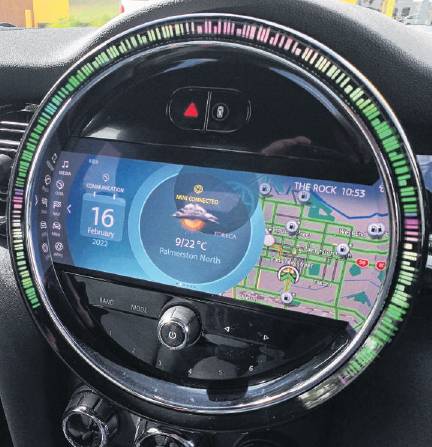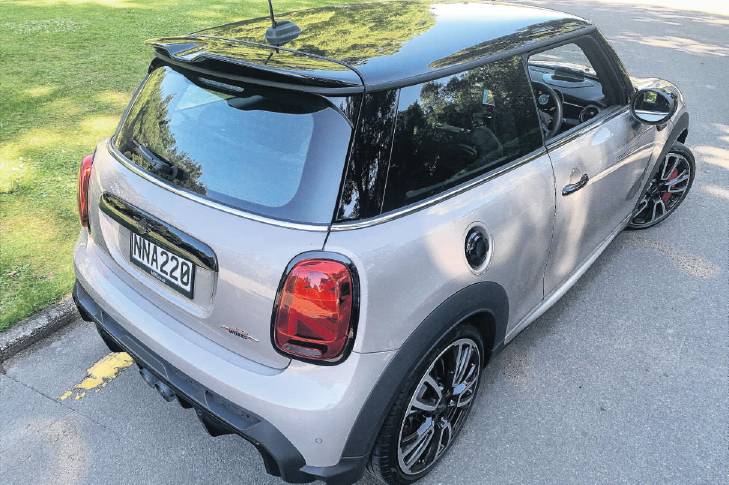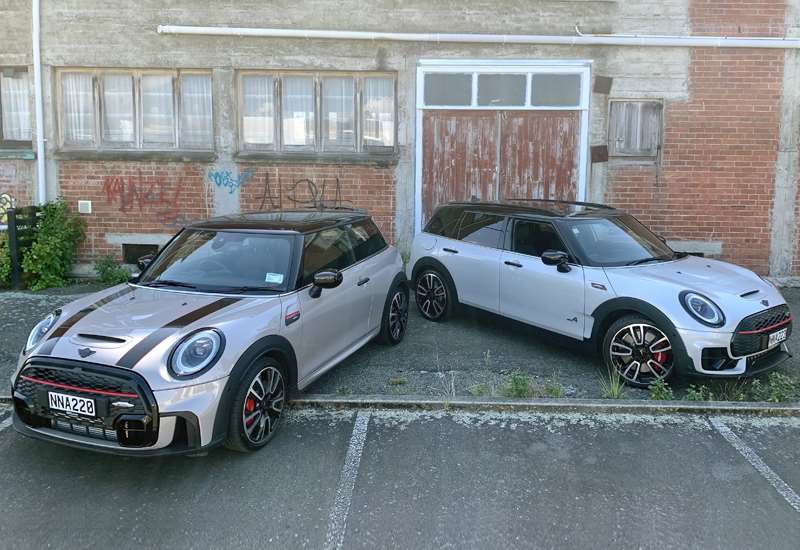The next few years are going to be a big time for Mini, writes Richard Bosselman.
The next-generation Countryman unveils later this year and in 2023 comes another crossover, plus all-electric small Minis co-developed with China’s Great Wall.
Also arriving is a new generation of petrol-powered products. No, really; As much as Mini has been talking a lot about moving to an all-electric model line-up, it recognises that some countries are better set for this than others. Accordingly the platform parent company BMW has allowed for future fare capable of electric, hybrid and internal combustion in one package.
Who gets what, and when, has not yet been spelled out. Kiwis are showing enlivened interest in electric, but even though recent buy-in has been impressive — including of Mini’s current sole fully electric offer, a hatch — the total New Zealand EV car park is still small: Just 40,000 units in total. Four times as many new passenger and light commercials were sold last year.
We could very well see more electric Minis; including the ‘‘China’’ car. We might just as likely see the others with internal combustion engines offered as a standalone, or with mild or plug-in hybrid systems.
Chances are the 2022 JCW — for John Cooper Works — editions, tested today in hatch and Clubman formats, are nonetheless the last of the wholly petrol-dedicated breed.
The firm says it’s “intensively” developing hot EV models, starting with a hardcore, performance-focused version with influence from the rad Pacesetter Formula E pace car.
The models on test today launched back in 2014 and were given a design update two years ago, when they gained those Union flag rear lights and other sundry revisions. Now they’ve been treated to further tweaks. Given that the car barely changes aesthetically, you might be wondering why the marque would bother, but they have.
JCW cars are always about pep. Nothing enhances on that front, but they’ve still got plenty.
Outputs from the 2.0-litre turbocharged four-cylinder engine common to both, but in different states of tune, remain unaltered. The 170kW/320Nm hatch will smack out 0-100kmh in 6.1 seconds, which is pretty decent but still a full second shy of the Clubman, which though a larger and heavier car also has another 55kW and 130Nm under its bonnet.
As much as the refresh stands as being an easy ride for the engine tuners, it’s certainly kept the styling department plenty busy, though there’s a fair bit of subtlety. The latest model identifies across the board by having a larger, reshaped hexagonal grille at the front. With the JCW cars this is in matt black and contrasted by a red stripe.
Body-coloured air ducts sit below the grille on either side of the number plate mounting point, feeding cool air into the braking system. Another set of angular air openings cool the powertrain.
There are minor detail changes at the back, too, such as a slim LED foglamp. Sitting square in the middle of the new diffuser is a set of 85-millimetre stainless steel sports tailpipes with a contrasting chrome finish. Also inbound are new colours and wheel designs.
Mini has redesigned the Brembo-provisioned brakes. The four-piston front calipers are also painted red and adorned with the John Cooper Works logo.
Inside, an 8.8-inch touch-reactive infotainment screen arrives and infotainment software has also been updated, benefiting from a revised display and controller that together more closely related to BMW’s iDrive and by and large make interfacing with the audio, navigation, communication and app systems more intuitive.

There’s been some minor tidying up of the switchgear and air vents, and everything is, of course, highly stylised; it wouldn’t be a Mini without plenty of toggle switches, not just ahead but also overhead.
As much as this approach layers into the car’s sense of occasion, even those fully immersed into the ‘vibe’ would surely still agree the liberal application of so many showy touches has some potential to irk or confuse, particularly for first-timers.
Regardless that its operability is up to speed, the touchscreen not being the largest makes it a bit hit and miss when on the move. Also, it seems a bit odd to have a rectangular display within a round area.
If you don’t already have an Apple communication device, best get one. This car is utterly prioritised for Car Play, brilliantly so. It now facilitates wireless connection and everything hooks up seamlessly and operates with any obvious glitches. Sure, you can still go old school and link up a phone by Bluetooth, but it’s not as efficient and the interaction can be a little sulky. Android Auto? It doesn’t compute.
One thing to watch out for: Mini’s achingly pure design requirements mean a standard-sized phone won’t quite fit properly into the recharging tray, underneath the centre armrest, if said device is in a protective cover, not even an ultra slimline one.
The JCW also comes with a host of safety features as standard that include adaptive cruise control with stop and go functionality and parking assist, plus there are the usual creature comforts of heated seats and a heated steering wheel and a sunroof.

A bespoke chassis tune for the suspension comes as standard for the JCW, and as an optional extra, buyers can tick Mini’s Adaptive Suspension box.
These electronically controlled dampers make adjustments to suit the road conditions in just 50-100 milliseconds, for a more dynamic ride. There are a number of different modes that can be selected depending on the driver’s mood, which includes ‘Lounge’ and ‘Sport’ mode. In other works, hit the switch to achieve various degrees of joltiness.
Still, all part of the ethos, right?
John Cooper Minis were true standouts during the 1960s and the influence the late great Briton’s F1 championship-winning touch had on these cheeky cars is recognised now by these models.
The hatch is probably more authentically relevant, insofar as back in Cooper’s day, it was the only focus for hotting up. The only presumable motorsport use for a Mini van — which is what the Clubman kinda is, if only because it has those barn-style rear doors — would have involved parts delivery.
Today’s Clubman has morphed into a totally upmarket and very plush model now, more than several social classes above the 1960s muse. It’s a decent-sized five-seater car, with good boot space.
Though it is not really a hot hatch in its styling, it is certainly very much one in intent, with enough oomph to go toe-to-toe with the similarly-priced Mercedes-AMG A35 and Audi S3. Not bad for a model that might almost pass as a boutique bakery’s delivery van.
The hatch is quite a bit bonkers, too. More than it potentially should be, given an eight-speed auto is involved. Yet the Sport mode is emphatically that; the gearchanges hold much longer and become snappier at much higher revs and in either state of tune the engine sounds rorty, with pukka snap-crackle-pop emotion.
With the hatch everything downloads thorough the front wheels. The Clubman, on the other hand, has an on-demand AWD, which has a mechanical diff lock to help traction up front and minimise torque steer. It also alters its feed in that optimal fun setting, sending more to the rear.
JCW cars have a stiffer body structure and are lower than standard Mini offerings. This, plus with geometry alteration for faster cornering and more dextrous hard-driving handling, means you get rather a lot of firmness for general driving. But that’s JCW-typical. Likewise, the beefed-up brakes that can seem a little snatchy and meaty low-profile tyres are of a type that’ll likely be worn down by coarse chip regularity.
In either, there’s such massive front-end grip you feel inspired to be quite brave in entering corners, though ultimately it’s the AWD model in which you have stronger sense of it being a faithful apex magnet.
The steering is awesome, with excellent weighting and good feel and feedback.
In either, there’s a level of competence that a driver of an original Mini Cooper simply wouldn't believe possible.
The reason for the Clubman’s parking space-filling design becomes evident when you’re the cabin. It’s the rarest of Minis in being almost maxi. Rear-seat room is generous enough to make it appealing to someone of my above-average height. When dropping down that back seat, too, the boot becomes very commodious.
You cannot say the same with the hatch. It’s not a shoebox, but neither does it deliver the family car appeal of the larger offer.
As much as people might still like to sneer at BMW’s Mini even after all these years, there’s no doubt Munich has done a great job with this revival. Bear in mind that the ‘‘German’’ Mini has been much more successful commercially than BMC’s original ever managed.
- Richard Bosselman





